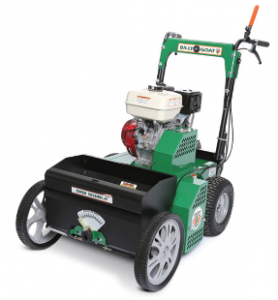The new line of Vanguard single cylinders is designed to be a direct replacement for the Honda GX. It even uses the same mounting points, so manufacturers can easily switch to this new engine family. While both Vanguard and Billy Goat are owned by Briggs & Stratton, Billy Goat continues to offer engines from several manufacturers to best fit their equipment.
What makes the new 203cc Vanguard’s design stand out is its concentration on reduced operating costs:
– Cyclonic air filtration extends air filter replacement to up to 600 hours
– An improved oil management system extends oil life to up to 200 hours
– TransportGuard automatically shuts off fuel, preventing oil from being diluted by gasoline during transport.
– Cold weather features, including automatic decompression, make the engine easy to start down to -20°F.
– The carburetor and fuel delivery system are both resistant to stale fuel. Vanguard says the gas tank doesn’t need to be drained for storage as long as the fuel is treated with a stabilizer.
This engine also has the longest warranty available. It’s covered for three years 3 years from purchase for commercial and residential users. Once you register your engine with Vanguard, they extend the warranty to four years.
Which Billy Goat Models Use this Engine?
Choosing between a Vanguard and a Honda isn’t just a matter of brand preference. In some cases, the new engine offers performance benefits.
– AE402V
The AE400 is a great alternative to small drum aerators. It has a reciprocating tine system that won’t damage turf, and it uses a water tank instead of steel weights. The 203cc Vanguard engine produces 6.5 HP, compared to the 3.5 HP made by the Honda GX120 used in the AE401H.
PL1802V
Billy Goat recently updated their 18 inch wide aerator, making it possible to cover 22,000 square feet per hour. Improvements include better wheel bearings, a longer lasting belt drive system, and a handle-mounted tine retracting lever. The PL1802V weighs 8 lbs. more than the Honda-powered PL1801H and Vanguard 205cc-powered PL1801V models. The PL1801V’s engine is an older design that doesn’t have the long service intervals of the new 203cc engine.
– PL2501SPV
This aerator has a 25 inch wide aerating width, but otherwise is very similar to the PL18. The Vanguard makes 1.7 more horsepower than the Honda GX160 in the PL2501SPH.
– F1402V and F1402SPV
These wheeled blowers fit between the F13 contractor blower and the F18 municipal blower. Total output is close to the F18, but the F14 uses a smaller outlet. The SPV comes with hydrostatic drive. This makes the blower easier to move, and increases working speed.
New or Old, We Have Everything You Need for Your Billy Goat
Billy Goat Parts is an authorized dealer for Billy Goat, as well as their manufacturing partners including Vanguard, Briggs & Stratton, Subaru Industrial, Kohler and Honda Engines. We have sections on our website dedicated to different engine families, or you can use our search engine to find parts specific to your model. If you need anything for your Billy Goat, visit us at www.billygoatparts.com. We can ship your order to any address in the USA or Canada.

